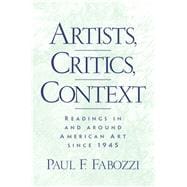
Note: Supplemental materials are not guaranteed with Rental or Used book purchases.
Purchase Benefits
Looking to rent a book? Rent Artists, Critics, Context Readings in and Around American Art since 1945 [ISBN: 9780130908988] for the semester, quarter, and short term or search our site for other textbooks by Fabozzi, Paul F.. Renting a textbook can save you up to 90% from the cost of buying.
| Preface | p. ix |
| The American Avant-Garde | p. 1 |
| My Painting (1947-1948) | p. 2 |
| The Romantics Were Prompted (1947-1948) | p. 3 |
| What Abstract Art Means to Me (1951) | p. 5 |
| Towards a Newer Laocoon (1940) | p. 10 |
| The American Action Painters (1952) | p. 23 |
| The New American Painting (1959) | p. 32 |
| The Spiritual Problem of Modern Man (1933) | p. 37 |
| Art and Materialism in the Beat Generation | p. 55 |
| I am for an art ... (1961/1967) | p. 56 |
| Happenings in the New York Scene (1961) | p. 60 |
| The Artist Speaks (Interview with Dorothy Gees Seckler (1966) | p. 68 |
| The New Art (1963) | p. 76 |
| Howl (1955-1956) | p. 85 |
| Dog (1955) | p. 94 |
| Experimental Music (1957) | p. 96 |
| Mass Culture, Mass Media, Pop Art | p. 101 |
| What Is Pop Art? (Interviews by Gene Swenson) (1963 and 1964) | p. 102 |
| The Arts and the Mass Media (1958) | p. 115 |
| A Symposium on Pop Art (1963) | p. 119 |
| Perspective from the Biltmore Balcony (1960) | p. 139 |
| Television: The Timid Giant (1964) | p. 145 |
| Objectivity, Reduction, and Formalism | p. 167 |
| Excerpts from Painters Painting (1970) | p. 168 |
| Specific Objects (1965) | p. 173 |
| Paragraphs on Conceptual Art (1967) | p. 180 |
| Reflections (1973) | p. 184 |
| A B C Art (1965) | p. 186 |
| Modernist Painting (1965) | p. 201 |
| A Future for the Novel (1965) | p. 208 |
| Process and Materials | p. 215 |
| Anti Form (1968) | p. 216 |
| An Interview with Eva Hesse (by Cindy Nemser) (1970) | p. 219 |
| Nauman Interview (by Willoughby Sharp) (1970) | p. 225 |
| Verb List (1972) | p. 234 |
| Anti-Illusion: Procedures/Materials (1969) | p. 235 |
| Music As a Gradual Process (1968) | p. 243 |
| Sculpture in the Environment | p. 246 |
| Cultural Confinement (1972) | p. 247 |
| Sun Tunnels (1977) | p. 250 |
| Interview by Barbaralee Diamonstein (1979) | p. 258 |
| On the Periphery of Knowing (Interview by Jan Butterfield) (1976) | p. 269 |
| Gordon Matta-Clark's Building Dissections (Interview by Donald Wall) (1976) | p. 274 |
| Sculpture in the Expanded Field (1979) | p. 283 |
| The Primacy of Perception and Its Philosophical Consequences (1964) | p. 292 |
| Theory, Politics, and Performance | p. 307 |
| Interview with Hans Haacke (by Robert C. Morgan) (1979) | p. 308 |
| Excerpts from The Dinner Party: A Symbol of Our Heritage (1979) | p. 318 |
| Catalysis: An Interview with Adrian Piper (by Lucy Lippard) (1972) | p. 330 |
| Untitled Statements (1975) | p. 334 |
| Sexual Politics, Art Style (1971) | p. 339 |
| Black Creativity in Quest of an Audience (1970) | p. 343 |
| Hans Haacke's Cancelled Show at the Guggenheim (1971) | p. 346 |
| I've Been to the Mountaintop (1968) | p. 356 |
| Linguistics and Politics (1969) | p. 364 |
| The Return of Painting | p. 380 |
| Statement (1980) | p. 381 |
| Expressionism Today: An Artist Symposium (Interviews by Carter Ratcliff and Hayden Herrera) (1982) | p. 382 |
| American Painting: The Eighties (1980) | p. 389 |
| The Adversary Culture of Intellectuals (1979) | p. 404 |
| Identity and Technology | p. 418 |
| Talking Art with Carrie Mae Weems (Interview by bell hooks) (1995) | p. 419 |
| Charles Ray: A Telephone Conversation (Interview by Francesco Bonami) (1992) | p. 430 |
| A Diary of Fluids and Fears (Interview by Francesco Bonami) (1993) | p. 434 |
| Interview with Gary Hill on Tall Ships (Interview by Regina Cornwell) (1997) | p. 437 |
| Art at the End of the Optical Age (Interview by Virginia Rutledge) (1998) | p. 443 |
| Art of the Living Dead (1992) | p. 452 |
| Coming Together in Parts: Positive Power in the Art of the Nineties (1993) | p. 469 |
| Video in Situ (1995) | p. 479 |
| The Work of Art in the Electronic Age (Interview by La Sept) (1988) | p. 484 |
| The Information War (1995) | p. 490 |
| Bibliography | p. 500 |
| Index | p. 504 |
| Table of Contents provided by Syndetics. All Rights Reserved. |
The New copy of this book will include any supplemental materials advertised. Please check the title of the book to determine if it should include any access cards, study guides, lab manuals, CDs, etc.
The Used, Rental and eBook copies of this book are not guaranteed to include any supplemental materials. Typically, only the book itself is included. This is true even if the title states it includes any access cards, study guides, lab manuals, CDs, etc.